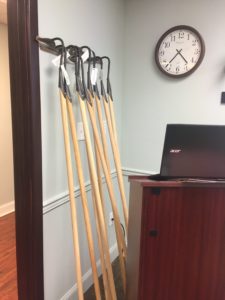“Right now everything is perfect.” says Deni Peterson at our first workshop on a cold Monday in March. “Dream big!”, she continues, “Sit by the fire and think of all the things you’d like to eat.” A huddled crowd is formed around the tent where notebooks, soil test kits, copies of Johnny’s Seed catalog, and ASD’s local food guide sit on a table waiting to be distributed. Deni goes on to talk about the anticipation of failure and how after 25 years of growing, she learns something new, she fails, and she learns some more. That’s the beauty in gardening, you’ll never get bored…well maybe bored of weeding.
Deni leads the crowd into the cover-cropped garden and opens a slit in the soil, demonstrating the ideal slice of a soil sample. Children volunteer to complete the rest as they zig zag through the winter wheat and snow peas opening soil and slicing samples. I notice folks are talking to each other, some have met before either at a kick-off meeting or at the “Great Seed Sort” of early March (I’ll talk more about this below). I’m hoping new friends are made this season. Cover-cropping is a new concept to this group and there are lots of questions about why we practice this technique.
We wrap up the meeting after an hour and floods of questions come in. This is my first season being Site Coordinator, so having 30 people waiting to talk to me was a bit overwhelming, but we made it through and everyone who signed up this season made it to the first workshops, “Soil Testing, Garden Design, and Early Crops”. We offer this workshop 4 times in order to get folks started off on the right foot or at least to the best foot for them. I’ve already received many soil test results and lime is beginning to be supplied and applied.

{Participants learn about cover cropping}

{Mixy, mixy, mixy}
This coming week we are offering our workshop, “Seed Starting and Transplanting Techniques: Greens, Peas, and Root Crops” where we will send home lettuce, spinach, peas, radish, carrots, turnips, and beets. Remember the first time you saw a lettuce seed? What about a turnip seed? Weren’t you impressed by something so small evolving into such a large plant?
I’m always impressed. Two volunteers and I sowed turnips and beets yesterday. One volunteer is a sophomore from the local high school, he’d never planted anything – he’s promised to come back each Thursday until school is out.
We talk a lot as Grow Appalachia sites about the benefit of buying seed in bulk and then repackaging it for use by our gardeners. Sounds simple enough, right? Simple it may be, but it takes organization, preparation, and finally lots of time to get all those little seeds into packages, labeled, and organized. We learned this the hard way last year by not providing enough direction and clarification, so we ended up with a bit of a mess. (See we’re learning all the time!)
Determined to not sort seed the day of a workshop this year, I organized ASD’s “Great Seed Sort”. I was delighted when 16 people from our community (not just GYO participants), showed up to spend their Friday afternoon with me sorting seed. We were even able to get most of our tools assembled and the remainder of our gardener notebooks assembled. One of our second year growers, actually donated bird house gourd seed that she’d saved last year for distribution to the group.
Tilling is set to begin next week and folks are more than ready to start growing! Stay happy and healthy Grow Appalachia family!








Leave A Comment